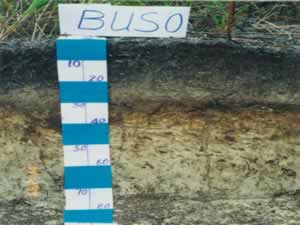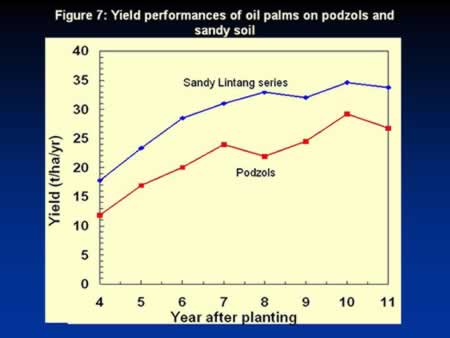Problem Soils: Managing Podzols or Spodosols
[addw2p name=”problemSoils”]

Buso
Podzols generally occur within BRIS (Beach Ridges Interspersed with Swales) soils although they have been found on moderate hills in East Malaysia. The total extent of these soils in Peninsular Malaysia alone has been estimated at 162,000 ha (Choo, 1991). Majority of these soils are used for tobacco, vegetables, cashew nut trees and star-fruit trees. Of late, some of these soils which occur in the plantations have been cultivated with oil palms.
The major constraints in Podzols are perched water table, low nutrient status and CEC and poor moisture retention capacity. Some podzols may not have perched water table and these soils resemble quartzipsamments, which are discussed later.
The obvious first priority is to remove the stagnant water on the soil surface. This is easily accomplished by digging scupper drains with lower depths breaking the hard spodic horizons. The intensity of drains is usually 1 in 8 palm rows although this varies with sites. The top width of the drain is 60 cm and the bottom width is 30 cm to allow for more gentle slope, therefore easier maintenance.
Upon surface drainage, the conditions reverted to the other extreme of likely severe moisture stress due to excessive drainage and low moisture retention capacity. Hence, water conservation practices similar to those described for lateritic soils earlier must be improved immediately. The EFB mulching rate should be increased to 60 to 80 t ha-1 yr-1 and this is continued for at least 5 years before a lower rate is adopted.
The poor nutrient status and retention capacity pose a dilemma of high total fertiliser input but low rate at each application. This is generally solved by using compound or mixture fertilisers supplemented with straight fertilisers. The total fertiliser applications may reach 7 to 9 rounds a year and this should minimise leaching losses. Despite the sandy soils with anticipated low P fixing capacity, high phosphate rock is still recommended to ensure good root development and activity. Very high rate of ground magnesium limestones (GML) is also necessary to build-up the soil Mg status and prevent Mg deficiency.
Good ground vegetation is also important in reducing the surface soil temperature, which helps to reduce soil water evaporation and improve microbiological activity. The leaf litter return also binds the soil particles for better structure and aggregation.
Our experiences with planting oil palms on Podzols with satisfactory rainfall or more than 2000 mm yr-1 has been encouraging as shown in Figure 7.

